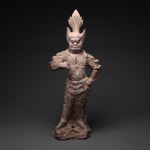T'ang Sculpture of a Lokapala, 618 CE - 906 CE
Painted Terracotta
height 54 cm
height 21 1/4 in
height 21 1/4 in
H.753
Further images
During the Tang Dynasty, restrictions were placed on the number of objects that could be included in tombs, an amount determined by an individual's social rank. In spite of the...
During the Tang Dynasty, restrictions were placed on the number of objects that could be included in tombs, an amount determined by an individual's social rank. In spite of the limitations, a striking variety of tomb furnishings have been excavated. Entire retinues of ceramic figures - animals, entertainers, musicians, guardians - were buried with the dead. Many of the objects reflect Tang China's extraordinary amount of contact with foreigners, bringing into China influences that were then adapted and absorbed into its culture. One of these influences is apparent in this figure that corresponds to Buddhist warrior deities that assume a mortuary role in China but also serve as protectors of Buddhist temples. Known as "Protector of the Burial Vault" or "Protector of the Burial Ground," the fierce, this armored guardian stands atop a grotesque demon. This stance symbolizes the heavenly king's authority and responsibility as protector of the tomb.
A remarkable amount of this sculpture’s originally pigment has survived the ravages of time intact, perhaps most visible in the individual whiskers of his beard and moustache. According to one Chinese tradition explaining their origin, the emperor Taizong when ill was threatened by ghosts outside of his room screeching and throwing bricks and tiles. When his general Jin Shubao (Chin Shu-pao) and a fellow officer came to stand guard the activity of the ghosts ceased. The grateful emperor had portraits of the two men hung on either side of his palace gates, and thereafter their images became widespread as door-gods. Originally, he would have brandished a weapon fabricated in a material such as wood that has deteriorated over the centuries. Looking unto his stern face and flaming hair and gazing into his fierce eyes, we understand why such works were intended to frighten away tomb robbers and evil spirits. Yet despite his intimidating nature, we are not repelled by him; instead, we are attracted to his artistic mastery and intriguing history.
A remarkable amount of this sculpture’s originally pigment has survived the ravages of time intact, perhaps most visible in the individual whiskers of his beard and moustache. According to one Chinese tradition explaining their origin, the emperor Taizong when ill was threatened by ghosts outside of his room screeching and throwing bricks and tiles. When his general Jin Shubao (Chin Shu-pao) and a fellow officer came to stand guard the activity of the ghosts ceased. The grateful emperor had portraits of the two men hung on either side of his palace gates, and thereafter their images became widespread as door-gods. Originally, he would have brandished a weapon fabricated in a material such as wood that has deteriorated over the centuries. Looking unto his stern face and flaming hair and gazing into his fierce eyes, we understand why such works were intended to frighten away tomb robbers and evil spirits. Yet despite his intimidating nature, we are not repelled by him; instead, we are attracted to his artistic mastery and intriguing history.







